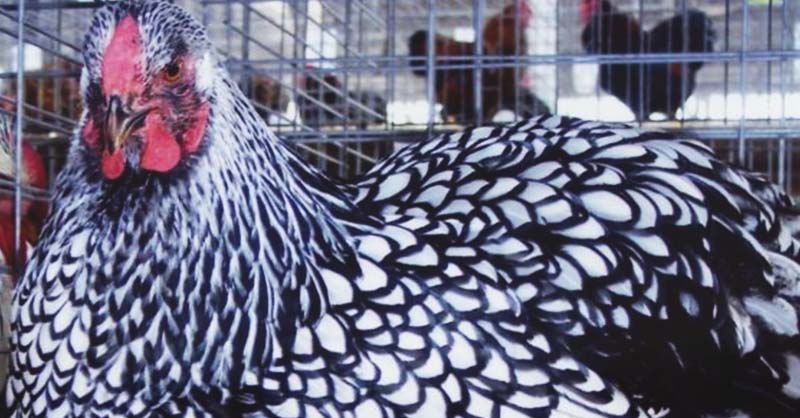Wyandottes are generally regarded as the most suitable breed for life on the farm by most homesteaders. Wyandottes piqued my interest for their exquisite plumage when I was researching chicken breeds I wanted to own.
For years, the versatility of chicken keepers has made this breed attractive. Wyandottes are excellent layers, egg producers, and mother queens who waltz around the yard showing off their gorgeous feathers.
About Wyandotte Chickens
The Wyandottes were created in 1870 by four persons, and the name Wyandot came from a local American tribe. Hamburgs and Dark Brahmas are thought to have been the most important breeds in the development of Wyandotte chickens, despite their origins being hazy.
The breed’s initial color variety was Silver Laced Wyandottes, however other colors have been developed and accepted into the American Standard of Excellence. Black, blue, buff, Columbian, golden-laced partridge, silver-laced silver penciled. The most often seen and favorite type is the laces.

Wyandotte Chicken Characteristics

1. Size and Weight
Wyandottes are not particularly small birds because they are classified as a dual-purpose breed. Roosters average 8 to 9 pounds, while hens average 6 to 7 pounds. The fluffy feathers of the Wyandottes give them the illusion of being even bigger than they are.
Since it would be difficult for a hawk to transport such a massive bird, this works in their favor when it comes to free ranging. Your Wyandottes will probably be free to roam freely while a bird of prey the size of a hawk or smaller goes for something smaller and easier to take off with.
2. Temperament
Wyandottes are moms that are kind and subordinate. Roosters are distrustful of humans but are effective flock protectors. To avoid barnyard scuffles, make sure you don’t overpopulate the flock versus the number of hens, since some flock keepers have encountered particularly territorial roosters.
3. Egg Production
Wyandotte hens are actually good egg producers, despite the fact that many dual-purpose breeds suffer from poor productivity. In a year, a hen will produce around 200 medium-sized, light brown eggs.
4. Meat Production
Wyandottes are a heritage breed that grows slowly because of their age. Because Wyandotte roosters can produce a decent sized carcass when fully grown, they are good candidates for those who wait. Hens will be smaller, but the meat will still be excellent.
Taking Care of Wyandottes

1. Feeding and Nutritional needs
Wyandottes only need a normal laying feed, which you can get at your local feed shop, in their diet. Supplemental calcium is essential for your birds to produce healthy eggshells and feathers, so make sure you always offer it.
2. Housing Requirements
To ensure there is no crowding, the Wyandottes’ house will need a bit more space per bird (4 to 5 square feet). The coop should have 10 to 12 square feet per bird. If you have enough room for your birds to roam, Wyandottes make excellent free-range foragers.
Make sure that your home is neither drafty nor well-ventilated. Because of their body mass and snugly fitting comb, wyandottes do well in chilly environments, so don’t sweat it if the evenings get chilly.
3. Health Issues and Treatments
Outside of ordinary chicken problems, Wyandottes are rather hardy birds that do not have any particular health issues. As always, keeping your birds happy and healthy requires a good environment, so prevention is crucial.
4. Breeding
Time and patience are required for the breeding of laced Wyandottes. To ensure the intricate feather patterns are up to standard, breeders attempting for perfection in Wyandottes must put in extra effort.
To guarantee you get high-quality birds to start with, locate a trustworthy breeder to acquire breeding stock from. Tackle a challenging job and win, and there isn’t much that is more satisfying. It’s worth breeding Wyandottes, just like it’s worth breeding any other bird!
Breed Alternatives
1. Barnevelders
In terms of appearance and proportions, Barnevelders are unmistakably Wyandottes. Due to their single combs, these birds are more tolerable in hot climates. Many people like the beautiful and intricate feather patterns of Wyandottes because they still exist.
Barnevelders lay around 180 black eggs per year, which is somewhat less than Wyandottes.
2. Orpingtons
Orpingtons lay about the same number of eggs as Wyandottes and weigh around the same amount. Orpingtons are also excellent moms, and this breed is somewhat friendlier and more submissive than Wyandottes. Buff, blue, black, and lavender are the most common color varieties for Orpingtons. There are also several gorgeous Orpingtons varieties that are highly desired.
Fun Facts About Wyandottes
- Bantam-size Wyandottes are also available! Bantam Wyandottes are a bit more difficult to come by than standard-sized Wyandottes. Bantams might be a good fit for a chicken keeper, especially since they come in a smaller package than Wyandottes.
- The Wyandottes have a gorgeous rose comb. Their hardiness to cold temperatures, as well as their distinct appearance, make them particularly resistant to frostbite.
Wyandottes have captured the hearts of many homesteaders, chicken keepers, and poultry enthusiasts. The Wyandotte will probably suit your needs in whatever you’re seeking from a chicken!

